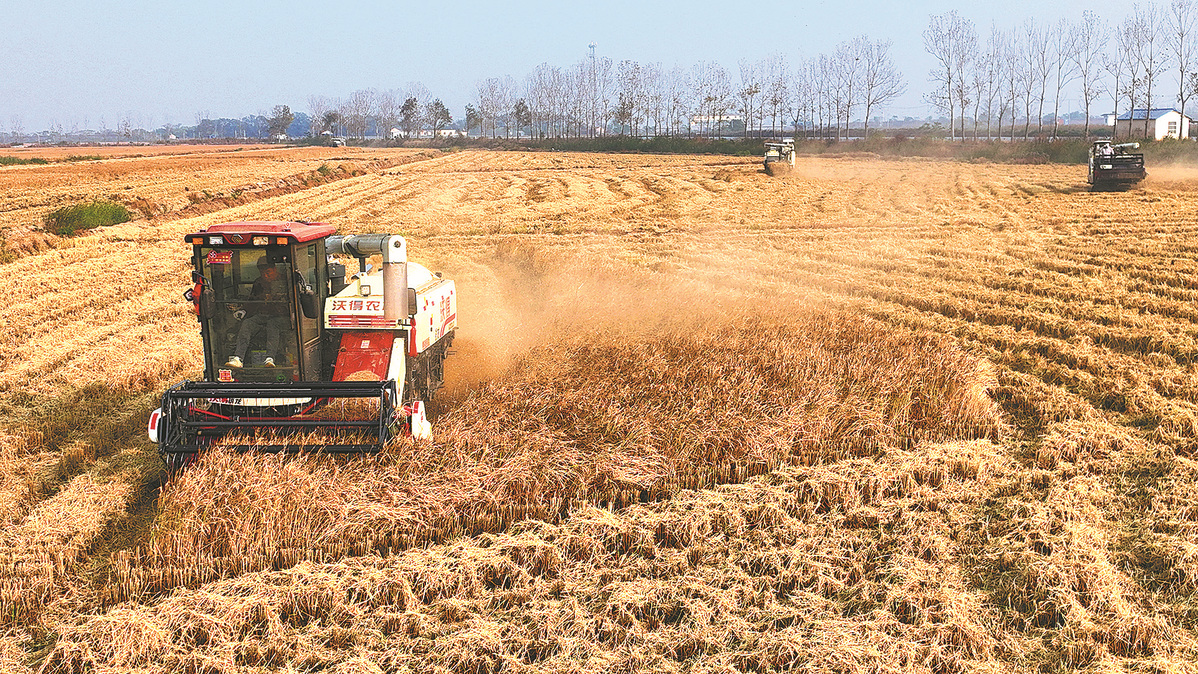Seeds of hope spring from seawater rice (2)
Seawater rice is harvested at a farm in Lianyungang in November. GENG YUHE/FOR CHINA DAILY
"Most of the saline land in the northwest is located in dry or very dry regions," he said.
Wang Qingxue, 60, a farmer in Dongying city, Shandong province, said: "The saline soil on my family's arable land is near the Yellow River, while that of my cousin is near Bohai Bay. Both areas can be exploited, as they are close to wetlands, so this soil is not such a big problem."
Dry areas of the country are the biggest problem. For example, in Lankao county, Henan province, saline soil accounts for 36 percent of the total agricultural land. Combined with wind and sand, this situation has posed major challenges to local agriculture.
A vicious circle formed. Dry weather turned the soil saline, which meant it could not support plant or crop growth. As a result, there was no natural barrier against the wind, while sand that accumulated worsened the condition of the soil, so it was unable to retain water.
Even good arable land was affected, as evidenced by Shen Tianmin, a wheat breeding expert from Kaifeng city, Henan, who said in 1962 that wheat production in Lankao was only 12 kilograms per 0.67 hectares.
Two years later, Jiao Yulu, 42, the Lankao Party chief, who led locals in transforming 6,000 hectares of saline soil into arable land, died from liver cancer. In 2017, Lankao eradicated poverty after transforming a high percentage of saline soil into arable land to support crop growth.
Increased output
Salt-tolerant rice can grow in saline soil with water containing 0.6 percent salt, which covers a relatively high percentage of China's saline soil, thus increasing the nation's rice production.
Zhang Guodong, vice-director of the Qingdao research center, said, "Quite a high proportion of saline soil in China has a salt content of more than 0.6 percent, but by watering the rice plants, we keep the salt content in water surrounding their roots at around that level, thus helping them grow well."
In 1930, it was discovered in Ceylon — now Sri Lanka — that wild rice could grow in saline soil, marking the start of research in this field.
In comparison, such research in China did not begin until the 1980s, when Chen Risheng, an agricultural scientist in Zhanjiang city, Guangdong province, found that some rice plants could grow on the coast in this area.
Chen collected more than 500 seeds and grew them on an area of local wetland. After five years, he harvested 3.8 kg of seeds that had grown steadily — naming the crop Sea Rice 86 to mark the year in which he made the discovery.
After decades of research, China took the lead globally in seawater rice research thanks to the late academician Yuan Longping, known as the "father of hybrid rice", and his team.
Zhang said, "Seawater rice breeding is part of hybrid rice breeding, in which China has long been the undisputed champion of the world." In 2012, Yuan and Chen set up a team to research seawater rice. By 2016, Yuan had coordinated national resources and founded the Qingdao Saline-Alkali Tolerant Seawater Rice Research and Development Center.
Yuan set three goals for the pair: Seawater rice must be able to withstand water with a salt content of 0.6 percent or more, thus saving water resources; to be economically sustainable; the yield must reach 300 kg per 0.67 hectares; and the total plantation area should be more than 6.67 million hectares for planting seawater rice to be a sustainable industry in China.
 |  |
Photos
Related Stories
- China to improve functions of agriculture and rural affairs ministry
- UN official says Chinese Juncao technology holds key potential to contribute to achievement of UN SDGs
- Intelligent agriculture drives rural vitalization in NW China’s Ningxia
- Zengcheng in S China's Guangzhou pursues high-quality development of agriculture
- Farmers in NW China’s Qinghai celebrate start of spring farming
- Chinese rice production expertise impresses Malawian authorities
- Locals in C China's Fu'an Village receive drone operation training for spring ploughing
- Smart farming advances China's modern agricultural development
- Spring farming underway across China
- Spring plowing boosted by State measures
Copyright © 2023 People's Daily Online. All Rights Reserved.










